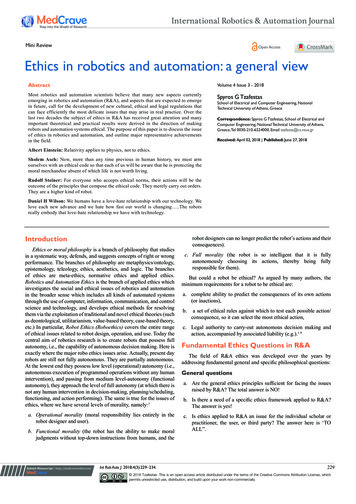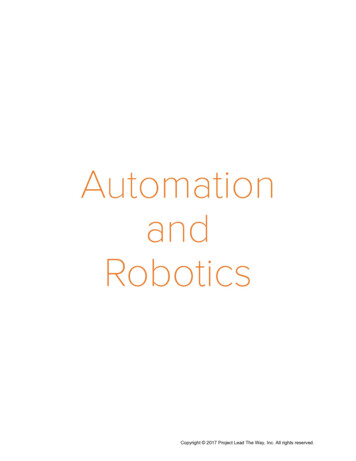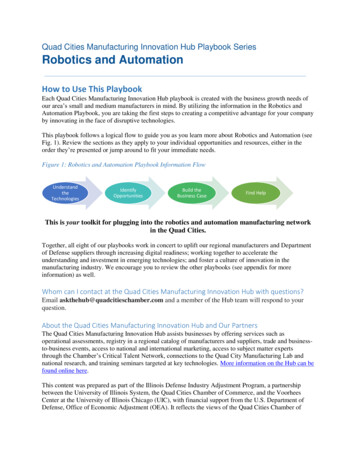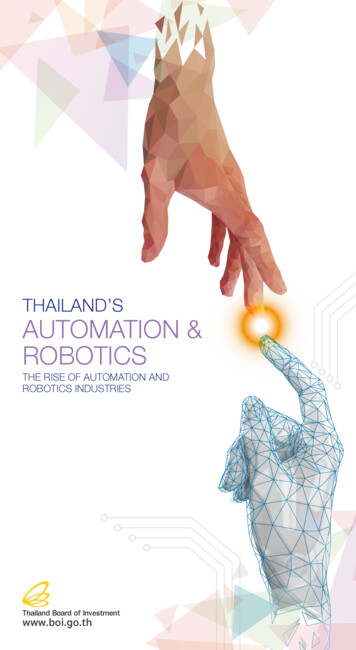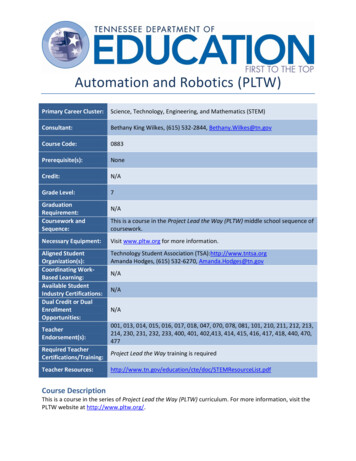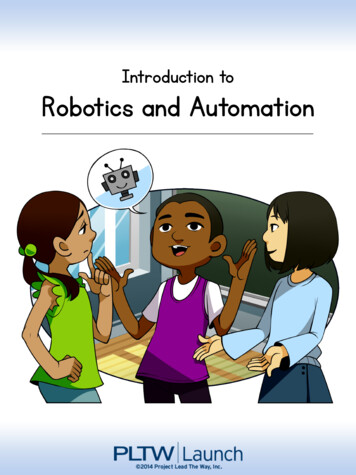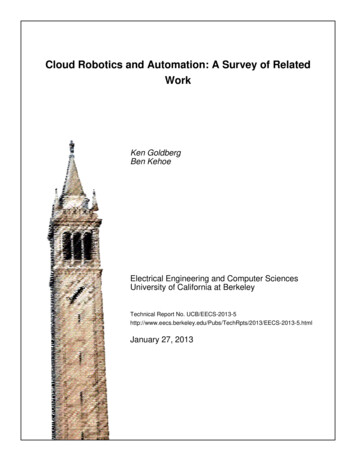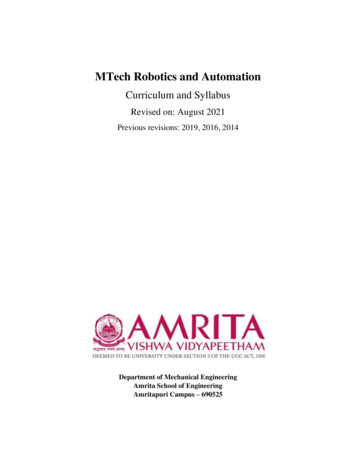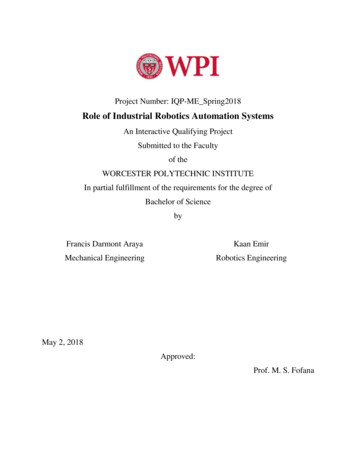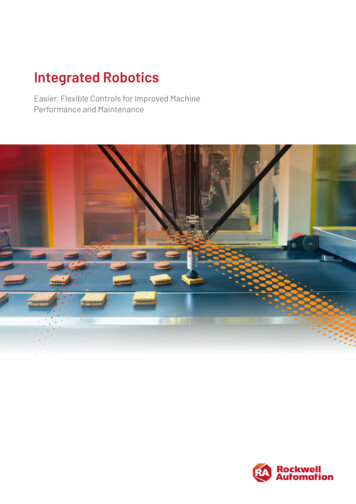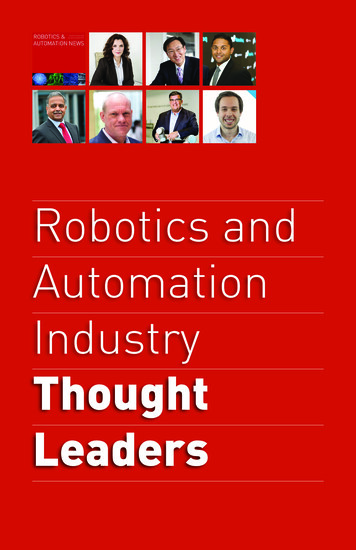
Transcription
Robotics andAutomationIndustryThoughtLeaders
Robotics and Automation Industry Thought Leaders2RoboticsAndAutomationNews.com
Robotics and Automation Industry Thought Leaders Chapter 1: IntroductionRobotics and AutomationIndustry Thought LeadersIt’s been a year since the launch of the Robotics and Automation Newswebsite, and as part of our celebrations, we are moving into bookpublishing, the first one being this one, a collection of some of the bestinterviews we have conducted over the past year. It’s the first of a series,as we interview interesting people from the tech world on an ongoingbasis, and we thought people might like to purchase the conversations ascollections contained within a book such as this one.The original idea for the website – RoboticsAndAutomationNews.com – was to initially cover the world of industrial robots and theautomation systems generally found in factories. While we have tried tokeep our attention on those subjects, we also became interested in therelated developments in connectivity, such as the internet of things, andcomputing, such as artificial intelligence.The whole subject, if seen as an interconnected series of subject,has become quite large and involving. We can’t claim to have inventedanything, and we hesitate to claim any innovations in our editorial, butwe do find it interesting to connect subjects together. In doing so, we findourselves realising that subjects that previously may not have been seenas robotics-related deserved reassessment and perhaps reclassification.For example, a car which is driven by a computer rather than ahuman is now generally accepted as a type of robot, whereas it might nothave been before. A building which features many intelligent systems,such as responsive lighting, heating and other controls, could be classedas a robot. The building itself may not be mobile and be stationary,unlike a car, but it still has plenty of moving parts and automated andautonomous control systems.There are other examples, but it’s worth noting that there is currentlya lively debate about what exactly constitutes a robot, and we try andtake our lead from experts as well as add ideas of our own.Our own view is that a robot is any hardware that has some type ofRoboticsAndAutomationNews.com3
Robotics and Automation Industry Thought Leaderssoftware which serves as its brain. However, we recognise that this viewmay be too simplistic, as that would include desktop computers, whichis already a classification that people recognise and accept, and we don’twant to redefine things and add to the confusion.But it’s difficult to ignore what some people – including us – mightcall virtual robots, perhaps illustrated best by Automator, which is anapplication which has been included with the macOS for many years.While this type of robot is not autonomously mobile and has no movingparts, the implications of the technology are too profound and thepossibilities too interesting for us not to cover it on the website.Having said that, we try to avoid becoming another “tech” website,which usually indicates a website which deals with computingtechnology – desktop computers, mobile tablets, smartphones, and thesoftware that enables them to function. There are plenty of excellentwebsites which deal with those subjects, and it’s tough to see how anypublisher could add anything significant to what’s already on offer.We try to remind ourselves that we deal with mechatronics – acombination of software and hardware which has moving parts, generallyspeaking. But only time will tell if we are blending things logically, or ifwe’re making a mishmash of disparate and disconnected technologies.In this endeavour, we appreciate the help of the many thoughtleaders from the robotics, automation and wider technology industry,who have been willing to spend time sharing and articulating theirideas. We believe these thoughts and ideas could, in and of themselves,lead to innovations and developments that otherwise might nothave been considered and researched. We can’t think of many moresatisfying things than to be involved in – or at least be providinga platform for – discussions which could lead to better or moreinteresting technologies or ways of doing things, which in turn, maylead to better lives for everyone. l 4RoboticsAndAutomationNews.com
Robotics and Automation Industry Thought LeadersRoboticsAndAutomationNews.com5
Robotics and Automation Industry Thought LeadersChapter 2 : Jane ZavalishinaIf AI Ruled the WorldInterview with Jane Zavalishina, CEO, Yandex Data Factory ome people say artificial intelligence will eventually take over theworld, and make humans obsolete and useless in large parts ofsociety, starting with firing us from all employment – low-skilled or high.Others say it’s already happened – that AI rules the world.From artificially intelligent assistants which answer your emails andmanage your diary, to artificially intelligent industrial robots that cancustom manufacture products to individual customer specifications andthat can tell you when they need a little maintenance, not to mention the AIin the latest cars of today which can brake and change lanes to avoid youhaving an accident because you fell asleep at the wheel, AI is everywhere.And like the concept of the omnipresent deities that many religiouspeople believe in, AI – and its attributes of machine learning and deepS6RoboticsAndAutomationNews.com
Robotics and Automation Industry Thought Leaderslearning and so on – has inspired a massive global following which isgrowing every day.It’s growing so fast that the highly influential internet beacon O’ReillyMedia, which is credited with crystallising and popularising the concept ofOpen Source software, says “AI is going mainstream”. The company hasalso organised a massive event – the Artificial Intelligence Conference – todiscuss all the holy scriptures relating to the new religion.And it’s not just O’Reilly. All the big names in the tech world – fromGoogle and Apple to IBM and Microsoft – are falling over themselvesto pray at the altar of the one and only true supernatural power forwhich we can all see and experience tangible proof.Who wants to live forever?AI could even give us an actual afterlife, something other religionspromise but have yet to deliver in a verifiable way.And like most other gods, AI requires something of humans. And thatsomething is data – lots and lots of data infinite amounts of data. ForAI, as far as we know, has infinite power, because our brains, collectivelyif not individually, have infinite power. And it’s our brains that AI isessentially emulating, albeit at a performance level that has never beforeeven been imagined, much less achieved, by our own flawed but belovedhuman, all too human, brains.In this exclusive interview, we talk to Jane Zavalishina, CEO, YandexData Factory, a company which counts as one of its customers Cern,the atom-smashing scientific research facility which occupies hundredsof cubic miles under the ground in mainland Europe. There was once aworry that Cern’s experiments could inadvertently take humanity to hellby unwittingly creating a black hole into which we would all disappear.This has not happened. Or if it has, we’ve all made it through to the otherside without even noticing the journey.Facilities like Cern probably produce more data than any other typeof organisation and companies like Yandex Data Factory are there tocollect, collate and help scientists analyse that data. In the future it couldbe AI that routinely analyses the data and it could be AI that devises itsown particle physics experiments. This is already happening to someextent, but is it a good idea?RoboticsAndAutomationNews.com7
Robotics and Automation Industry Thought LeadersLet’s all panic nowAI doesn’t know why it’s doing what it’s doing. It doesn’t havehumanity’s best interests at heart – it doesn’t have any interests at all, andof course it doesn’t have a heart. Not unless these values are incorporatedinto it by the humans who develop the AI systems, and what guaranteesdoes anyone have that these humans are doing that? None, that’s what.Perhaps it’s too early to start worrying, but why not panic now beforeit’s too late and AI has completely taken over our brains, automatedus to oblivion and created the dystopian world so many science fictionstories have foretold?AI will put us out of work and out of business. So why not panic?According to Zavalishina, intellectual tasks will certainly beautomated to a high degree. We started by asking about this subject.Robotics and Automation News: What does Yandex Data Factorydo to automate intellectual tasks? What should companies look todo?Jane Zavalishina: Machine learning’s ability to replace humandecision-making by analysing data to determine the best appropriatenext step for routine, repetitive tasks means that it is ideally placedto lead the next generation of automation. Using data to determinethe best course of action within a set of finite rules is one thing, butempowering technology to draw its own conclusions, by learning fromempirical data – is quite another. This is where machine learning offersa competitive advantage through decision-making and automatingintellectual tasks by providing greater precision compared to rule-basedsystems and human analytics.To give an example – let us look at maintenance efforts that areperformed for any equipment or machinery. Typically, the decision toexecute maintenance or replace spare parts is guided by a pre-definedschedule and a set of conditional rules. Such rules are often guided byprevious statistics of faults or breakdowns, but they are widely genericand tend to be suboptimal in terms of costs incurred. In fact, maintenanceis always a balancing act, as both excessive support efforts and potentialbreakdowns and delays mean potential losses.Equipment maintenance is a good example of a process that can beautomated with the help of machine learning. Instead of simply following8RoboticsAndAutomationNews.com
Robotics and Automation Industry Thought Leadersa predefined schedule or responding to alerts, a machine learning-basedpredictive model can be built. This complex model can precisely predictpotential breakdowns before they happen or before they are detectedthrough human analysis. This is achieved through the analysis of pastmaintenance data, performance and machine telemetry. This also allowsfor the ordering of spare parts to be done automatically. Eventually, thisreduces costs and automatically streamlines servicing efforts.When it comes to machine learning, it’s important to remember thatthe more relevant the data fed into decision-making, the more accurateand appropriate the decision made. But equally, the bigger the amountof data, the greater the need for machine learning and automation dueto the sheer complexity of the calculations and impossibility to properlyleverage the data without the help of machines. That is what we offerat Yandex Data Factory – the development of such machine learningmodels that help companies automate routine decision-making to achievemeasurable business results.Companies are investing in machine learning not because it’s a fador because it makes them seem pioneering. They invest in it becausethey are seeing the opportunity for rapid positive return on investment.Being able to predict success more accurately or avoid potential lossespreemptively are game changing benefits and something companies willalways strive for.What in the long run do you think will be a challenge for AIdevelopers? What is the intellectual quality that humans havethat robotics/automation/AI will not now or possibly ever be ableto emulate?The greatest challenge for AI is for it to explain its actions – why ithas done what it has. While machine learning is capable of automatingmany intellectual tasks, AI developers are faced with the challenge ofreplicating the human brain and rationale. No small feat.The main challenge lies in establishing trust towards AI – as it isoften impossible to rationalise machine learning in the same mannerwe rationalise and justify our actions – simply due to complexity ofdecision-making and a vast number of factors taken into account.When it is impossible to understand the “thought process” behindthe machines, the only way to build the trust is through experimentsRoboticsAndAutomationNews.com9
Robotics and Automation Industry Thought Leadersdemonstrating and measuring the direct value brought by the smartalgorithms. Establishing this experimental culture in businesspractice will lead to greater trust and, as a result, a greater divisionof labour, and increasing readiness to accept machines without fear,doubt or scepticism from humans.However, there is one thing machines still cannot do: creativityand defining the best actions in the absence of past historical data. Thisstrategy guidance and bold risk-taking is still reserved for humans, andwill continue to be for a while yet.What are the economic implications for AI – good or bad?Data compiled by Deloitte from the census data for England and Wales,stretching back to 1871, has shown that technology has created more jobsthan job losses. Nonetheless, some have come to fear AI due to a beliefthat as automation becomes more sophisticated, the need for human inputwill decrease and jobs will be lost.In fact, while robots may replace some roles, this shift to relying ontechnology will enable people to focus more on creative and strategictasks, changing the way they approach various processes and evenchanging industries altogether. The first step to this is for humansto assess which tasks machines will take on and which strategic andcreative tasks are to be dedicated exclusively to humans.This shift in the way humans and organisations work togetherwith machines will ultimately see the economy boosted by increasedefficiency. As tasks become automated and efficiency increases, we’llsee cost reductions on a large scale, improving entire industries andpropelling the economy forward.On the bright side, automation is likely to improve the quality oflife, especially for low-income households. Many things will becomemore affordable, and personalisation, facilitated by AI across variousindustries, will become a commodity.Will humans ever become slaves to the machines? Could thegrowth of AI have a negative impact on society?AI and automation will continue to evolve and its sophistication willheighten but far from becoming slaves to machines, humans willbe freed by them. With the onset of AI and automation, we will see10RoboticsAndAutomationNews.com
Robotics and Automation Industry Thought Leadersmachines take over the mundane which will leave humans with moretime and energy to explore different goals.Moreover, as costs are reduced, businesses will have moremoney to spend on things which may have otherwise beencompromised in favour of profitability – for example, corporate socialresponsibility or ethical activities.If humans want to make the most of AI, we must ensure that we learnhow to use these new technologies to their full potential so that theysupport our transition into strategic beings. nRoboticsAndAutomationNews.com11
Robotics and Automation Industry Thought LeadersChapter 3: Minoru Usui We Are Living in ‘ExtremelyTransformative’ TimesInterview with Minoru Usui, president, Seiko Epson hen you want to talk to someone about robotics and automation,especially in an industrial context, who better to talk to thanan expert from Japan? Not wishing to compound any stereotypes,the “land of the rising sun” has shown itself to be an early adopter ofmany, possibly all, advanced technologies for many decades now.When George Devol and Joseph Engleberger invented thefirst industrial robotic arm in around 1950, Japan was the mostenthusiastic buyer of their product, the Unimate. Devol andEngleberger had found business tough in the US, where there wasa general perception – perpetuated by Hollywood science fictionW12RoboticsAndAutomationNews.com
Robotics and Automation Industry Thought Leadersfilms – of robots as being an otherworldly, threatening menace. Whichthey are, of course.It’s inevitable that robots will take over the world and more orless enslave us, but when have humans ever listened to warnings ofour impending doom?There was a man who used to walk along Oxford Street, inLondon for many years during the 1990s, with big white messageboards strapped to his front and back. The message he carried in bigblack letters was, “The end of the world is nigh”. Did anyone payany attention? Of course not. Proof, if it were needed, that we justdon’t listen to people who can see the future and make it clear to us inblack and white, until it’s too late.Maybe he got the timing wrong, but that guy was onto something.Our world is ending, and the robot world is beginning. Should webe worried? Of course we should. But what can anyone do to stop themarch of progress? Mass unemployment caused by increasing use ofrobotics and automation technologies, and let’s not even get into thefrankly apocalyptic prospect of ubiquitous artificial intelligence running,ruling and possibly ruining our lives. What can anyone do against theoverwhelming forces of human nature, the drive for progress, the greed,the lust for power and money, especially when it’s combined with suchfascinating and alluring, not to mention lucrative, technology?But maybe we shouldn’t worry too much. Maybe the robots come inpeace. Maybe they just want to help us become more productive, give usmore free time to enjoy our lives, sometimes known as unemployment.Maybe the change they will inevitably bring will be a gradual process,providing us with plenty of opportunity to adjust and adapt. And maybewe don’t have to study where the Luddites went wrong so we can dowhat they did, only better.Whatever we decide, the societal upheavals heralded bythe accelerated development of AI-based technologies are not onlyinevitable, they are already happening.In this exclusive interview, Minoru Usui, president, Seiko Epson,gives Robotics and Automation News his views of the “transformative”effects of robotics on the world today, and looks forward to what dreamsor nightmares may come.Epson is one of the world’s largest robotics companies. TheRoboticsAndAutomationNews.com13
Robotics and Automation Industry Thought Leaderscompany has more than 50,000 robots installed around the world at lastcount, which was at least several months ago. Given that the past yearhas seen a huge hike in demand for industrial robots around the world,especially from China, Epson probably has much more than 50,000robots installed globally by now.In the UK, the company sells many SCARA and 6-axis robots. WhileBritain is fond of self-deprecation and much is made in the media ofwhat some observers – mostly “loony lefties” – see as the deliberatedecline of the manufacturing industry over the past few decades infavour of becoming a more service-oriented economy, mainly basedon financial services, the fact is that the country is still one of the top 10manufacturing nations in the world, with annual output valued at around 245 billion, according to government figures.However, while it may be a top 10 manufacturing nation, thecountry is somewhere near number 20 in the global list of robotdensity, and this is one of the main reasons for the relatively lowlevels of productivity in UK manufacturing, according to thegovernment’s Office of National Statistics.From Minoru Usui’s point of view, the UK, much like otheradvanced economies, can gain huge benefits from adopting more roboticsinto the manufacturing sector. The world is changing, he said, andBritain could change along with it. Usui began his career at Epson in thelate 1970s, which is about the time historians would probably say UKmanufacturing jobs moved to lower-wage, developing nations, and largeparts of Britain’s manufacturing industry started shutting down, throwingmillions of workers into unemployment and the country into politicaland social chaos, culminating in the Winter of Discontent. But there is achance that things can improve now, according to Usui.“We’re living through an extremely transformative period,characterised by major geopolitical, economic and technologicalchanges,” says Usui. “Shaped by these mega-trends, value chainsare being redistributed as production centres move closer to market;often back toward developed nations as the global wage gapcontinues to shrink. The shift of manufacturing back to the US andEuropean markets is well under way and robots can play a huge rolein this re-shoring trend.”One crucial factor in this possible reversal of manufacturing14RoboticsAndAutomationNews.com
Robotics and Automation Industry Thought Leadersfortunes and employment prospects, says Usui, is the fact that robots areapproximately the same price for everybody.“Their cost being the same wherever they are used, robots canmake a big difference in the spread of total labour costs in the UKand developed markets. In addition, robots are getting cheaper, moredexterous and easier to operate and could therefore help tackle thelooming issue of labour shortage in the manufacturing industry. Aboveall they are capable of delivering improved productivity and can reducethe need for outsourcing.”One perennial concern of British people is the cold weather. Inthe 1970s and even through the 80s, most people did not have centralheating, often using coal to heat their homes – not because of postmodern aesthetics but because their toes were freezing. Bitterly coldwinter weather made some jobs difficult, dangerous or even impossible.Even today, if there is any news that there may be a fuel shortage,something close to panic ensues and the government is placed underpressure to avert whatever catastrophe might occur.Usui says the UK can get by with a little help from robots. Theycould play a critical role in ensuring that British people’s toes, and thetoes of everyone around the world, are kept warm. And they have thepotential to be even more helpful in other ways and in other industries.He says: “In addition to manufacturing, robots are likely to play animportant part in tackling global trends such as securities shortages – inparticular fuel – and the ageing population.“Autonomous robots come with the potential to handle a greatnumber of tasks that require a precise, delicate touch, from food handlingto managing dangerous or volatile substances. Longer term, robots willbe suitable for deployment in high precision or high risk environmentswhere humans cannot, or should not, operate.“Power generation is a notoriously risky business – from miningto fracking to drilling for oil, to leveraging the opportunity of nuclearsolutions – these industries have always had their risks. What ifautonomous robots could take on the most dangerous of these tasks andbe used to work in the most high risk locations – a nuclear reactor, forexample? That possibility is approaching faster than you might think.”Mining is no longer a large-scale activity in the UK, afterMargaret Thatcher swung her formidable handbag and dealt theRoboticsAndAutomationNews.com15
Robotics and Automation Industry Thought Leadersindustry its final, decisive blow during her first term as primeminister, starting in 1979. The miners went on strike and the clashwent on for around a decade in what was one of the defining politicalconfrontations in the country’s modern history – lefty unions on oneside, right-wing bosses on the other, Thatcher being one of the mostright-wing leaders this country’s ever had.To some it may seem the recent past in terms of time – it was onlythe 80s. But when you look at how the economy has changed, it’sdifficult to imagine the coal industry being such a large and importantemployer and industry in the UK. These days, the talk is all about“digital Britain”, tech this and tech that. Silicon Square, Tech Triangle,Robot Roundabout. It’s a completely different place.And it’s likely to change even more. The robots have only just nowstarted to emerge in large numbers, ready to take over the world, havingbeen isolated in factories for so long. They also have new connectivitytechnology, a robot religion if you will, called internet of things(IoT), which allows more than three robots to congregate at one time,something Thatcher may not have allowed.Plus, Britain’s population, just like populations in Japan, Germany,the US and practically all advanced economies, is ageing. Around 10million people in the UK are over 65 years old, according to governmentfigures. That’s one in every six people. And the government is havingto think about how to look after them long term, particularly if largecorporations increasingly avoid paying taxes. The National HealthService might be free to end users, but it’s not cheap to maintain from thepoint of view of those who do pay their taxes.Usui believes robots could be the revelation the world has beenlooking for. “My future vision sees the capabilities of robotics extendinginto areas like assistive care, with robots helping us to address thechallenges of supporting an ageing population while reducing the costimplications – particularly when you consider their potential onceconnected to the internet of things.“As robots, along with other technology products, becomeincreasingly connected, collecting data from all around themand relaying it to the internet – as well as accessing and learningfrom data gathered by other machines – they will become a veryreal solution to supporting the service and care industries. This16RoboticsAndAutomationNews.com
Robotics and Automation Industry Thought Leaderssupport will manifest in multiple ways, not only with basic manualtasks such as lifting and moving, but also more complex taskssuch as measuring and sensing for environmental data, recordingand reporting changes and fluctuations, and providing data basedrecommendations and initiating tasks to apply them.“As they progress further to add artificial intelligence to theircapacity to learn, they will be a key solution in providing services withinthe home and care facilities, alleviating resource and labour pressuresand helping to improve service delivery and patient care.”Clearly Usui does not think the robots will use the IoT toorganise a revolution, or a global takeover. He doesn’t even thinkthey’re clever enough.“My belief is that robots will never be truly ‘intelligent’ – onlyever artificially so – and will always rely on humans to ultimatelyprogramme and ‘drive’ them. Robots, regardless of how clever, willremain tools. That said, they are tools with enormous potential andpower, and we must respect any technological advancement that hasthe potential to alter social dynamics. It is our responsibility to ensurethat they drive positive change.“I have no doubt that robots are destined to help us solve majorsocietal issues such as labour and skills shortages and costs, and willfinally realise their potential to release people from ordinary, dull ordangerous manual work, freeing more of us to concentrate on work thatdemands human intelligence. I have just as little doubt that they will beone of the keys to us solving numerous other fundamental global issues,relieving the pressure on our more finite resources.”Usui has been working with robots for almost 40 years, so heshould know what he’s talking about. He is obviously optimisticabout the future, and probably imagines a world where man andmachine will live as one.But then, that guy with the sandwich board also knew what he wastalking about, and I still say he was onto something. l RoboticsAndAutomationNews.com17
Robotics and Automation Industry Thought LeadersChapter 4: Saagar GovilElectrifying New MarketsInterview with Saagar Govil, chairman and CEO, Cemtrex lot’s happened since this website was introduced to Cemtrex afew weeks ago. The company’s been on a gigantic spending spree,buying up companies and restructuring its business for new markets asthough it were in a hurry to get somewhere fast.Where that somewhere is may be deduced from the acquisitionsCemtrex has made and the types of products and services in which theacquired companies specialise.Last month, Cemtrex purchased an obscure German companycalled The Target, an electronics manufacturer which supplies top-levelautomakers.Then, earlier this month, Cemtrex bought up and is synergising itsoperations with another German electronics manufacturer, Periscope. NotA18RoboticsAndAutomationNews.com
Robotics and Automation Industry Thought Leadersto be confused with Periscope the video streaming app, the PeriscopeCemtrex bought is another supplier to major automotive companies.It doesn’t take a genius to figure out what Cemtrex has its heart set on– the market for electronics used in autonomous vehicles.However, in this exclusive interview, Saagar Govil, chairman andCEO of Cemtrex, indicates that the company’s ambitions are not limitedto driverless cars and such – they include other nascent and excitingmarkets in what might be called “smart” clothes, except “smart” in thiscontext means they’re loaded with electronics which enable the clothesto gather information and maybe even change its state.So, for example, a jacket worn by a person taking a walk outdoorsmay have electronics which heat up the jacket if the weather is coldand cool down the jacket if the weather is hot. The safety issuessurrounding such wearable technology is certainly worth looking into,especially as the idea seems good and popular in principle, and these“smart” clothes are likely to be worn by millions of people very soon.Alpha geekCemtrex, which also owns brands such as ROB and Griffin Filters, hasn’tyet made all the financial details of the Target and Periscope dealspublic, but SeekingAlpha.com calls them “major acquisitions”, addingthat “Cemtrex management continues t
Robotics and Automation ndust out eades RoboticsAndAutomationNewscom 3 Chapter 1: Introduction Robotics and Automation Industry Thought Leaders It’s been a year since the lau

